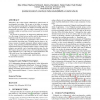261 search results - page 51 / 53 » Predicting category accesses for a user in a structured info... |
WIKIS
2006
ACM
14 years 6 days ago
2006
ACM
Wikipedia is the world’s largest collaboratively edited source of encyclopaedic knowledge. But in spite of its utility, its contents are barely machine-interpretable. Structural...
IDEAL
2009
Springer
13 years 11 months ago
2009
Springer
With the rapid and dramatic increase in web feeds published by different publishers, providers or websites via Really Simple Syndication (RSS) and Atom, users cannot be expected t...
SIGIR
2003
ACM
13 years 11 months ago
2003
ACM
Most existing clustering algorithms cluster highly related data objects such as Web pages and Web users separately. The interrelation among different types of data objects is eith...
KDD
2010
ACM
13 years 10 months ago
2010
ACM
Memory leaks are caused by software programs that prevent the reclamation of memory that is no longer in use. They can cause significant slowdowns, exhaustion of available storag...
POPL
2007
ACM
14 years 6 months ago
2007
ACM
A memory leak in a garbage-collected program occurs when the program inadvertently maintains references to objects that it no longer needs. Memory leaks cause systematic heap grow...

